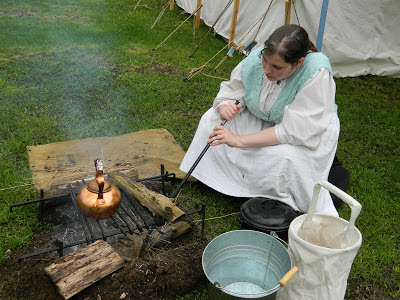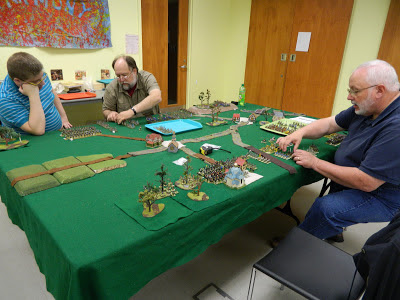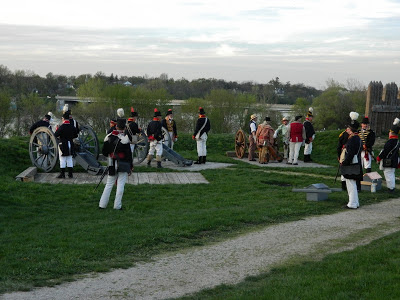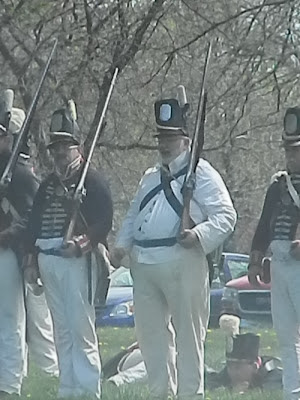The Backus-Page House and Museum in Wallacetown, ON holds an education day every year for grade 7 and 8 students. Last year, our group did not participate for a number of reasons, the foremost of which being schedule conflicts. This year, we were in the thick of things. On the Friday Ed Day, Beth and Katie portrayed "Camp Wives" or "Laundresses" at our tent camp. I drilled the "Mini-militia" and a few other fellows - Andy, Kevin, and Tyler - portrayed Canadian Militia ambushing my American militia unit. Rob was to be there but a special assignment at his school kept him out on Friday.
Basically, I teach the students to tell left from right, to come to shoulder arms, to fire their "muskets" (wooden shapes), to march, and to "charge their bayonets." (Imaginary bayonets, that is.) I try to give them a taste of military life during the Warof 1812. It's all pretty crude and rudimentary; some groups have fun, some resist and talk back. What gets them each and every time is the ambush. The students see the ambushers but don't expect them to actually fire their muskets - using blanks and elevating over the students' heads. The girls shriek and the boys laugh once they get used to the noise of the blanks.
 |
| Our training and ambush force - Kevin, Andy, Tyler, and myself - wearing sergeant's insignia! |
 |
"Your OTHER left!" "If you're comfortable, you're doing it WRONG!"
"Don't call me 'sir'! I work for a living!" |
 |
| Our station was a double one, having 30 minutes. Still I had to check the time once in a while. |
As I said, some of the groups got into it, some took it as a joke and flounced around. I attempted to get all "sergeant-y" on them with more success in the morning than the afternoon. A few of the students found the firing of cannon too upsetting by another station and had to sit out with upset stomachs. I guess I've been reenacting long enough that I hardly notice cannons firing, let alone musket fire. The one exception is the siege gun - a 24-pounder - at Fort Erie, which would make anyone sit up and take notice.
Meanwhile back at camp, Beth and Katie were doing the camp work and making some mighty tasty chicken stew. Their role is to teach about what was done in camp and what the women did on campaign, including the rations, the pay, and the life in camp. They try to impress upon these 13-14 year-olds that facts that at their age, the girls would most likely be married and the boys would be preparing to enter the army or navy. This is always a moment of enlightenment for them. (
"You mean we wouldn't be in school?" "No, you'd be raising babies or learning to march. How do you like them apples?")
 |
| Katie tends the fire with a kettle to make tea. |
 |
Katie and Tyler's son set out the toy soldiers - made from clothes pins.
Tyler's father made them when he was reenacting, now another generation has them. |
 |
Katie and Tyler work on the fire. This is a Saturday photo and the black iron
Dutch Oven contains the beginnings of macaroni and cheese,
done Thomas Jefferson style. |
Among the other education stations were artillery, candlemaking, rope making, a blacksmith, a glimpse of the life of the Native peoples, a small sail boat (on a trailer), and period songs and stories.
 |
| The Royal Artillery and the Provincial Marine discuss cannon. |
 |
| Your humble author takes five... with a cup of tea. |
 |
At lunch time, there was a weapons demonstration for the students.
Here White Turtle (aka Aaron) prepares to show the crowd how a hatchet
fares against a bayonet, as Tyler fixes his bayonet. |
 |
| Make ready! Aim! (or "Present!" if you serve the Crown) FIRE! |
On Saturday and Sunday, the grounds were open for all visitors and vendors arrived as well. More reenactors came in and there were two skirmishes each day. They were planned out as much as possible before-hand, but as usual things end up botched or slightly botched. Saturday morning, the Native scouts brought word of an advancing Yankee force, whose pickets soon appeared and headed toward a "farm house" where they terrified and terrorised the women folk. The Native warriors and the British Indian Department came on and a skirmish developed, the Americans being pushed back with the Natives and the BID in hot pursuit. Rob ran out and was tomahawked by Aaron.
 |
Saturday's troops of the Republic - Kevin, me, Rob as corporal, Tyler, and Andy.
I'm carrying a stick - a baton-of-office- as Kevin was borrowing my musket. |
 |
| Oh, yes! The artillery got into the act. Three cannons... |
 |
White Turtle comes to report the Yankee advance.
Ignore the cannon crew; they "weren't really there." |
 |
| Tyler and Rob recon the house. |
 |
| ... terrorising the women folk. |
 |
| The regulars, the militia, and the Kentucky Volunteers enter the fray. |
 |
| As a good sergeant, I offer encouragement and helpful suggestions to the men with the guns. |
 |
| Captain Roy of the BID does the same, but with cold steel. |
 |
| Tyler, Rob, Kevin, and Andy on the firing line. |
The afternoon skirmish added a cannon to the US side. Rob was captured by the First Nations warriors and roughed up by White Turtle and Many Strings. A truce was finally called and we received Rob back from the Crown forces in exchange for... a granola bar. I told Captain Roy, "Eat this, Captain. You get a little whifty when you're hungry." Later on, I got a Snickers® bar and did this again at a planning meeting.
Sunday morning, -while it was 4° C - I was working so Rob was sergeant as the US forces chased off the BID and the Native warriors as the Crown forces held the top of the hill. Since Andy had to be elsewhere and I was at work, some reenactors exchanged their BID clothing for US militia or Canadian Volunteer uniforms. (These were Canadian who served the US Army as guides and light infantry, in their grey roundabouts and top hats with green turbans. Raiffe -on the far right- is in that uniform.) Both Katie and Beth were quite busy with the public so there appears to be only one photo.
 |
Captain Roy is taken off into captivity by the Kentucky Volunteers while Sergeant Rob
looks on proudly. I was told by many people that he did a fine job as sergeant. |
The afternoon skirmish took place close to the public. The three cannons set up on the hill and the American troops were lounging behind a rickety breastwork made from a few log benches. After the bombardment, the BID came in from the right and the Native warriors from the left. We all got hacked down by clubs and tomahawks - all made of very realistic looking foam rubber, and we died -like men- to a man. Aaron came back, "scalped" me, and took my glasses to see what sort of magic these things were. Thus ends my term as sergeant. Again, Beth and Katie were working with the public at the campsite, so no photos, sad to say.
It was a good little event, although the weather did not cooperate. As we were taking out tents down, it began to hail... in May. That's okay - it snowed a little bit when Beth and I were mowing our lawn on Monday. Welcome to South-western Ontario! If you don't like the weather, wait 5 minutes! The folks at Backus-Page House cannot be blamed for the weather, and everything else went fine. They served an excellent dinner on Saturday evening, of roast beef, rolls, potato salad, and other vegetable salads. For dessert... apple crisp, cooked on the fire by my wife and daughter, rhubarb crisp baked elsewhere, and other taste treats.
The staff and volunteer of the Backus-Page House and Museum are to be complimented on a great event. They worked very hard and in my opinion, it went well. They told us reenactors when they wanted the skirmishes and let us do the planning and let us do our thing! What else could you ask? I hope to be back next year.
 |
Tyler's son - one happy warrior! He was busy shooting zombie coyotes.
Best not to ask. |
 |
My wife, Beth and I in full gear. I couldn't do this without her!
She sews! She cooks! She bakes! She plans!
She still tolerates me after 25 years of marriage.
She is amazing and I love her. |
On a last note, the stick I carried as sergeant was my Dad's keep-the-dogs-away-on-my-walk stick as he got to be close to 90 years old. In World War II, he was a master sergeant in the US Army. In some small way, this weekend, I was "the Minstrel Boy", an Irish musician and "his father's sword he has girded on..." I suppose I carried that stick in memory and in honour of Harold Goldsworthy, Major, US Army Reserve (ret.), who has passed on.
 |
| The BID keep up a hot fire with Sergeant Mike at the near right. |
This week - at the games club: "Imagi-nations" again. Freedonia on the march!

















































































